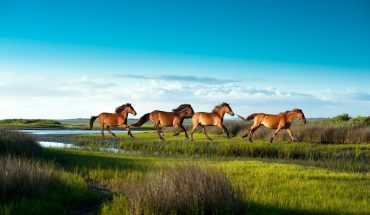
by Jesma Reynolds
photograph by Juli Leonard
It’s an early evening in late summer, and Andy Schmidt is walking the grounds of her rural home in Cumberland County. Lilly the horse, inherited from the previous homeowner, saunters over to a fence as Schmidt pulls a handful of pokeberries from a nearby bush, crushing them in her hand to reveal a brilliant purple hue. Considered an invasive weed by most (and poisonous to humans), this artisan sees pokeberries and the other plant matter and botanicals she forages as essential ingredients for the non-toxic dyes she makes for custom textiles.
Her label, Rise and Ramble, is a deceptively simple collection of shift-like dresses, tops, and accessories that spotlights her fascination with all things natural. Less than a year in the making, Rise and Ramble’s small-batch capsule collections have already made their way to upscale indie craft markets across the region and to pop-up shops at Raleigh Denim’s Curatory and Port of Raleigh.

Some current Rise and Ramble designs hang on a clothesline.

Pokeberries are a good source for Schmidt’s custom dyes.
Her latest creations are posted on her website and circulated on social media. Part commerce, part journal, her Instagram feed documents Schmidt’s emerging designs and explores her inspirations in nature and art. The works of Milton Avery and Alexander Calder, with their focuses on movement, lines, shape, and color, inform her own.
Schmidt, 30, has long had an interest in design. As a student at Meredith College, she majored in fashion design merchandising and took all the studio art classes she could, learning about color theory and fiber arts. She spent a semester abroad studying in Paris, where she snagged a short-term internship with designer Elie Saab during fashion week and got a behind-the-scenes tutelage in putting together a runway collection. Upon graduation, she began her career as a visual merchandiser for Urban Outfitters in Austin, Texas, and started dabbling in creative projects on the side.

Schmidt’s rural home studio is where she uses different dyeing techniques to create one-of-a-kind garments.
After reading about natural dyeing with red onion skins, she decided to experiment on a white chiffon skirt she had found to wear to an upcoming friend’s wedding in the Czech Republic. She made multiple trips to the grocery store to scour the bottom of bins for discarded skins, and created a dye for the skirt. The result – a subdued yellow-green stain – exceeded her expectations. “The natural color palette is so beautiful. I was amazed with what you can do with stuff people throw away,” she says.
Soon, this would-be alchemist was buying books to learn more about the science and process of dyeing. She experimented on her porch with pomegranate skins, avocado skins, and other vegetables and fruits to concoct custom elixirs. On walks, she would collect things from nature – flowers, berries, and sticks – to work with. More testing on vintage clothing and “blanks” (think white T-shirts) allowed her to see the various results she could get from her natural potions. “I love how you get something different based on different harvests,” she says.

Schmidt ties up a textile with organic materials that she will dye.

Frozen flowers are rolled up in fabric and dried overnight.
This past January, Schmidt began to work on creating simple dress and tunic patterns, and in late March, debuted her first Rise and Ramble collection. With natural fabrics like silk, cotton gauze, and linen, she kept the lines of the garments simple and drapey, allowing her the freedom to focus on her real passion – dyeing. For each season, she offers a made-to-order collection that includes subtle ranges of colors and patterns that reflect the unique characteristics of each dye batch. For those who want to buy what they see, there is a section offering one-of-a-kind pre-dyed garments. This fall, she’s working on keeping the same simple shapes, but is considering some subtle tweaks, like adding sleeves or perhaps a pocket. Of course, the colors will shift as the season changes.
Back in her garage studio, Schmidt lifts the lid off a massive turkey fryer-cum-dye pot where a bunch of birch leaves salvaged from a recent tree trimming are soaking in water. A saucepan of onion skins simmers on a tabletop gas burner. Out on the porch, small jars housing test batches of flowers steep in solar baths, akin to sun tea, to extract color slowly. Because some flowers can’t withstand high heat, she arranges camellia petals on a piece of fabric that is rolled and tied tight to resemble a long shish kebob – then she steams and dries it overnight.

Schmidt pats Lilly, a horse inherited from the previous owner.
Once unrolled and treated in a mordant (a substance that sets the dye), the layered imprint of the flowers leaves an ethereal, abstract impression of pattern and color. Hemp silk fabric she uses takes color faster than the heavier textured cotton. Tearing the silk into long strips, she says, “I love the noise the fabric makes as it rips across the grain.”
There is a rhythm and intention to her work as Schmidt divides her weeks into sewing days and dyeing days. She hopes to plant a dye garden for next spring, where she can grow flowers like dahlias and camellias and host workshops for would-be dyers. Whatever the future holds, in Schmidt’s world everything is pretty, naturally.



